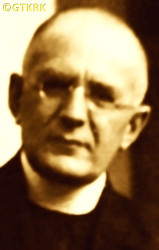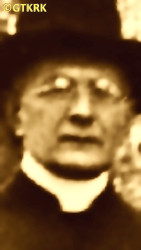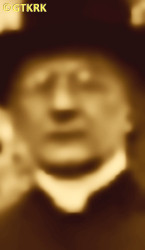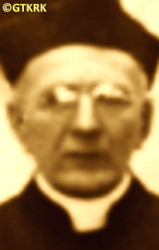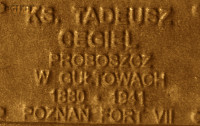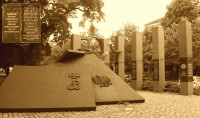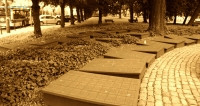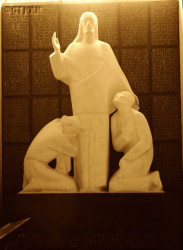Roman Catholic
St Sigismund parish
05-507 Słomczyn
85 Wiślana Str.
Konstancin deanery
Warsaw archdiocese, Poland
full list:
displayClick to display full list

searchClick to search full list by categories
wyświetlKliknij by wyświetlić pełną listę po polsku

szukajKliknij by przeszukać listę wg kategorii po polsku

Martyrology of the clergy — Poland
XX century (1914 – 1989)
personal data
surname
CEGIEŁ
surname
versions/aliases
CEGIEL
forename(s)
Thaddeus Vladimir Cornelius (pl. Tadeusz Włodzimierz Korneliusz)
forename(s)
versions/aliases
Vladimir Cornelius Thaddeus (pl. Włodzimierz Korneliusz Tadeusz)
function
diocesan priest
creed
Latin (Roman Catholic) Church RCmore on
en.wikipedia.org
[access: 2014.09.21]
diocese / province
Gniezno and Poznań archdiocese (aeque principaliter)more on
www.archpoznan.pl
[access: 2012.11.23]
date and place
of death
18.10.1941

KL Posenconcentration camp
today: Poznań, Poznań city pov., Greater Poland voiv., Poland
more on
en.wikipedia.org
[access: 2022.01.09]
alt. dates and places
of death
21.10.1941
details of death
In 1908, during Prussian rule in part of partitioned Poland, supported publically Polish candidates to the Germ. Preußischer Landtag (Eng. Prussian National Parliament).
At the end of 1918, after outbreak on 27.12.1918 of the Greater Poland Uprising 1918‐1919, following his appeal an insurgent unit was formed in Gułtowy.
After German invasion of Poland in 09.1939 and start of the World War II, after start of German occupation, for the first time arrested by the Germans prob. c. on 26.08.1940, during the second wave of arrests of Polish Catholic clergy in the Germ. Reichsgau Wartheland province, established in the occupied Greater Poland region.
Held in DL Scheglin transit camp in Szczeglin.
Prob. released.
Arrested again on 07.10.1941, as part of the third action to eliminate the Polish Catholic clergy in the Germ. Reichsgau Wartheland.
Transported to KL Posen (Fort VII) concentration camp where perished. Did not live to see 30.10.1941, when all the Polish priests arrested at that time in the Germ. Reichsgau Wartheland were transported to the German KL Dachau concentration camp.
According to the death certificate in the registers of the civil registry office in Poznań, No. P 3680/1941, the „honest” otherwise German „medical doctors” and formalists — and at the same time, unrivaled fairy tale spinners — noted the cause of death was „heart stroke”.
cause of death
murder
perpetrators
Germans
sites and events
KL PosenClick to display the description, 06.10.1941 arrests (Warthegau)Click to display the description, DL ScheglinClick to display the description, 26.08.1940 arrests (Warthegau)Click to display the description, Reichsgau WarthelandClick to display the description, Ribbentrop‐MolotovClick to display the description, Pius XI's encyclicalsClick to display the description, Greater Poland UprisingClick to display the description
date and place
of birth
16.08.1880Birth certification on:
www.genealogiawarchiwach.pl
[access: 2025.09.08]

Inowrocławtoday: Inowrocław gm., Inowrocław pov., Kuyavia‐Pomerania voiv., Poland
more on
en.wikipedia.org
[access: 2021.07.18]
parents
CEGIEŁ Vladislav
🞲 ?, ? — 🕆 ?, ?

KOZŁOWICZ Leocadia
🞲 ?, ? — 🕆 ?, ?
presbyter (holy orders)
ordination
10.02.1907

Gnieznotoday: Gniezno urban gm., Gniezno pov., Greater Poland voiv., Poland
more on
en.wikipedia.org
[access: 2021.12.18]
positions held
1933 – 1941
dean — Kostrzyntoday: Kostrzyn gm., Poznań pov., Greater Poland voiv., Poland
more on
en.wikipedia.org
[access: 2021.12.19] RC deanery
1917 – 1941
parish priest — Gułtowytoday: Kostrzyn gm., Poznań pov., Greater Poland voiv., Poland
more on
en.wikipedia.org
[access: 2021.07.25] ⋄ St Casimir the Prince and Confessor RC parish ⋄ Kostrzyntoday: Kostrzyn gm., Poznań pov., Greater Poland voiv., Poland
more on
en.wikipedia.org
[access: 2021.12.19] RC deanery
1935
administrator — Czerlejnotoday: Kostrzyn gm., Poznań pov., Greater Poland voiv., Poland
more on
en.wikipedia.org
[access: 2021.07.25] ⋄ Blessed Virgin Mary of the Assumption RC parish ⋄ Kostrzyntoday: Kostrzyn gm., Poznań pov., Greater Poland voiv., Poland
more on
en.wikipedia.org
[access: 2021.12.19] RC deanery — acting („ad interim”)
1916 – 1917
administrator — Gułtowytoday: Kostrzyn gm., Poznań pov., Greater Poland voiv., Poland
more on
en.wikipedia.org
[access: 2021.07.25] ⋄ St Casimir the Prince and Confessor RC parish ⋄ Kostrzyntoday: Kostrzyn gm., Poznań pov., Greater Poland voiv., Poland
more on
en.wikipedia.org
[access: 2021.12.19] RC deanery
1911 – 1916
vicar — Gnieznotoday: Gniezno urban gm., Gniezno pov., Greater Poland voiv., Poland
more on
en.wikipedia.org
[access: 2021.12.18] ⋄ Holy Trinity RC parish (main parish) ⋄ Gniezno Holy Trinitydeanery name
today: Gniezno urban gm., Gniezno pov., Greater Poland voiv., Poland
more on
en.wikipedia.org
[access: 2021.12.18] RC deanery
1910 – 1911
curatus/rector/expositus — Markowicetoday: Strzelno gm., Mogilno pov., Kuyavia‐Pomerania voiv., Poland
more on
en.wikipedia.org
[access: 2021.06.07] ⋄ Blessed Virgin Mary of Mount Carmel RC church ⋄ Ludziskotoday: Janikowo gm., Inowrocław pov., Kuyavia‐Pomerania voiv., Poland
more on
en.wikipedia.org
[access: 2021.07.18], St Nicholas the Bishop and Confessor RC parish ⋄ Żnintoday: Żnin gm., Żnin pov., Kuyavia‐Pomerania voiv., Poland
more on
en.wikipedia.org
[access: 2021.06.20] RC deanery
1909
vicar — Inowrocławtoday: Inowrocław gm., Inowrocław pov., Kuyavia‐Pomerania voiv., Poland
more on
en.wikipedia.org
[access: 2021.07.18] ⋄ St Nicholas the Bishop and Confessor RC parish (main parish) ⋄ Inowrocławtoday: Inowrocław gm., Inowrocław pov., Kuyavia‐Pomerania voiv., Poland
more on
en.wikipedia.org
[access: 2021.07.18] RC deanery
1907 – 1909
vicar — Kłeckotoday: Kłecko gm., Gniezno pov., Greater Poland voiv., Poland
more on
en.wikipedia.org
[access: 2021.07.18] ⋄ St George and St Hedwig of Silesia RC parish ⋄ Gniezno St Peter and St Pauldeanery name
today: Gniezno urban gm., Gniezno pov., Greater Poland voiv., Poland
more on
en.wikipedia.org
[access: 2021.12.18] RC deanery
till 1907
student — Gnieznotoday: Gniezno urban gm., Gniezno pov., Greater Poland voiv., Poland
more on
en.wikipedia.org
[access: 2021.12.18] ⋄ philosophy and theology, Archbishop's Practical Theological Seminary (Lat. Seminarium Clericorum Practicum)
from 1903
student — Poznańtoday: Poznań city pov., Greater Poland voiv., Poland
more on
en.wikipedia.org
[access: 2021.07.18] ⋄ philosophy and theology, Archbishop's Theological Seminary (Collegium Leoninum)
from 1917
membership — Poznańtoday: Poznań city pov., Greater Poland voiv., Poland
more on
en.wikipedia.org
[access: 2021.07.18] ⋄ Friends of Sciences Society
others related
in death
FLACHClick to display biography Julian, GRAMLEWICZClick to display biography Edward, HARASYMOWICZClick to display biography Vincent, JANICKIClick to display biography Stanislav, JANKOWSKIClick to display biography Alphonse, KUBIKClick to display biography Alexander, ŁUKOWSKIClick to display biography Steven, MAŁECKIClick to display biography Stanislav, MANITIUSClick to display biography Gustav, MIROCHNAClick to display biography Steven Marian (Fr Julian), MZYKClick to display biography Louis, NIEDBAŁClick to display biography Anthony Marian, NOWAKClick to display biography Francis Joseph, PIOTROWSKIClick to display biography Ignatius, POPRAWSKIClick to display biography Marian, SĘKIEWICZClick to display biography Mauritius Vaclav, STEINMETZClick to display biography Paul, SZREYBROWSKIClick to display biography Casimir, TYMAClick to display biography Joseph, WIŚNIEWSKAClick to display biography Mary, WOŹNIAKClick to display biography Albin
sites and events
descriptions
KL Posen: German Posen — Fort VII — camp founded in c. 10.10.1939 in Poznań till mid of 11.1939 operated formally as Germ. Konzentrationslager (Eng. concentration camp) KL Posen, and this term is used throughout the White Book, also later periods. It was first such a concentration camp set up by the Germans on Polish territory — in case of Greater Poland (Wielkopolska) directly incorporated into German Reich. In 10.1939 in KL Posen for the first time Germans used gas to murder civilian population, in particular patients of local psychiatric hospitals. From 11.1939 the camp operated as German political police Gestapo prison and transit camp (Germ. Übergangslager), prior to sending off to concentration camps, such as KL Dachau or KL Auschwitz. In 28.05.1941 the camp was rebranded as police jail and slave labour corrective camp (Germ. Arbeitserziehungslager). At its peak up to 7‐9 executions were carried in the camp per day, there were mass hangings of the prisoners and some of them were led out to be murdered elsewhere, outside of the camp. Altogether in KL Posen Germans exterminated approx. 20,000 inhabitants of Greater Poland (Wielkopolska) region, including many representatives of Polish intelligentsia, patients and staff of psychiatric hospitals and dozen or so Polish priests. Hundreds of priests were held there temporarily prior to transport to other concentration camps, mainly KL Dachau. From 03.1943 the camp had been transformed into an industrial complex (from 25.04.1944 — Telefunken factory manufacturing radios for submarines and aircrafts). (more on: www.wmn.poznan.plClick to attempt to display webpage
[access: 2019.02.02], en.wikipedia.orgClick to attempt to display webpage
[access: 2013.12.27])
06.10.1941 arrests (Warthegau): On 13.09.1941 Germ. Gauleiter (Eng. regional leader) of German province Germ. Reichsgau Wartheland (Eng. Wartheland Reich district), in German‐occupied Greater Poland (where German standard law was in force), Artur Greiser, implementing „Ohne Gott, ohne Religion, ohne Priesters und Sakramenten” — „without God, without religion, without priest and sacrament” — policy issued a decree formally dissolving Catholic Church and forming in its place a Roman Catholic German National Church in Germ. Warthegau, an organization subject to a German private law. The ordinance was issued backdated to 01.09.1939, i.e. the date of the German invasion of Poland, which sanctioned the later robbery of the property of the Catholic Church acting for the benefit of the Polish population by the Germans. All the contacts with Vatican were forbidden. All the religion congregations were also dissolved. Soon after, on 06‐07.10.1941, mass arrests of Polish Catholic priests took place — c. 352 were detained. All were herded into DL Konstantinow in Konstantynów or IL Lond in Ląd on Warta river transit camps or KL Posen concentration camp (in this case, the detainees were first registered, photographed and examined in the infamous Poznań headquarters of the German political police, the Gestapo, in the former Soldier's House). On 30.10.1941 most of them were transported to KL Dachau concentration camp.
DL Scheglin: Germ. Durchgangslager Scheglin (Eng. Transit Camp) — German camp in Szczeglin n. Mogilno, operational from 01.10.1939 till 15.09.1940. Germans kept there c. 4,600 Poles, forcing them to perform slave labour — before transporting them to concentration camps. Among others on 29.08.1940 Germans sent from DL Scheglin 188 Polish priests to KL Sachsenhausen concentration camp. Approx. 150 of those held in DL Scheglin were murdered — some in the camp itself, the others in an execution site in Świerkowice forest. (more on: www.dsh.waw.plClick to attempt to display webpage
[access: 2013.06.23])
26.08.1940 arrests (Warthegau): As part of the Germ. „Ohne Gott, ohne Religion, ohne Priesters und Sakramenten” (Eng. „without God, without religion, without priest and sacrament”) policy, formulated by the Germ. Gauleiter (Eng. district head), Arthur Greiser, in the German province Germ. Reichsgau Wartheland (Eng. Wartheland Reichs District), organized by the Germans in the occupied part of Poland known as Greater Poland, hundreds of Polish priests were arrested on this day. Herded, together with priests arrested previously and held in IL Lond internment camp in Ląd on Warta river camp, among others, in DL Scheglin transit camp in Szczeglin n. Mogilno. Three days later all were transferred to KL Sachsenhausen concentration camp.
Reichsgau Wartheland: After the Polish defeat in the 09.1939 campaign, which was the result of the Ribbentrop‐Molotov Pact and constituted the first stage of World War II, and the beginning of German occupation in part of Poland (in the other, eastern part of Poland, the Russian occupation began), the Germans divided the occupied Polish territory into five main regions (and a few smaller). The largest one was transformed into Germ. Generalgouvernement (Eng. General Governorate), intended exclusively for Poles and Jews and constituting part of the so‐called Germ. Großdeutschland (Eng. Greater Germany). Two were added to existing German provinces. From two other separate new provinces were created. Greater Poland region was one of them, incorporated into Germany on 08.10.1939, by decree of the German leader Adolf Hitler (formally came into force on 26.10.1939), and on 24.01.1940 transformed into the Germ. Reichsgau Wartheland province, in which the law of the German state was to apply. The main axis of the policy of the new province, the territory of which the Germans recognized as the Germ. „Ursprünglich Deutsche” (Eng. „natively German”), despite the fact that 90% of its inhabitants were Poles, was Germ. „Entpolonisierung” (Eng. „Depolonisation”), i.e. forced Germanization. C. 100,000 Poles were murdered as part of the Germ. „Intelligenzaktion”, i.e. extermination of Polish intelligentsia and ruling classes. C. 630,000 were forcibly resettled to the Germ. Generalgouvernement, and their place taken by the Germans brought from other areas occupied by Germany (e.g. the Baltic countries, Bessarabia, Bukovina, etc.). Poles were forced to sign the German nationality list, the Germ. Deutsche Volksliste DVL. As part of the policy of „Ohne Gott, ohne Religion, ohne Priesters und Sakramenten” (Eng. „No God, no religion, no priest or sacrament”) most Catholic priests were arrested and sent to concentration camps. All schools teaching in Polish, Polish libraries, theaters and museums were closed. Polish landed estates confiscated. To further reduce the number of the Polish population, Poles were sent to forced labor deep inside Germany, and the legal age of marriage for Poles was increased (25 for women, 28 for men). The German state office, Germ. Rasse‐ und Siedlungshauptamt (Eng. Main Office of Race and Settlement) RuSHA, under the majesty of German law, abducted several thousand children who met specific racial criteria from Polish families and subjected them to forced Germanization, handing them over to German families. After the end of hostilities of World War II, the overseer of this province, the Germ. Reichsstatthalter (Eng. Reich Governor) and the Germ. Gauleiter (Eng. district head) of the German National Socialist Party, Arthur Karl Greiser, was executed. (more on: en.wikipedia.orgClick to attempt to display webpage
[access: 2024.06.21])
Ribbentrop‐Molotov: Genocidal Russian‐German alliance pact between Russian leader Joseph Stalin and German leader Adolf Hitler signed on 23.08.1939 in Moscow by respective foreign ministers, Mr. Vyacheslav Molotov for Russia and Joachim von Ribbentrop for Germany. The pact sanctioned and was the direct cause of joint Russian and German invasion of Poland and the outbreak of the World War II in 09.1939. In a political sense, the pact was an attempt to restore the status quo ante before 1914, with one exception, namely the „commercial” exchange of the so‐called „Kingdom of Poland”, which in 1914 was part of the Russian Empire, fore Eastern Galicia (today's western Ukraine), in 1914 belonging to the Austro‐Hungarian Empire. Galicia, including Lviv, was to be taken over by the Russians, the „Kingdom of Poland” — under the name of the General Governorate — Germany. The resultant „war was one of the greatest calamities and dramas of humanity in history, for two atheistic and anti‐Christian ideologies — national and international socialism — rejected God and His fifth Decalogue commandment: Thou shall not kill!” (Abp Stanislav Gądecki, 01.09.2019). The decisions taken — backed up by the betrayal of the formal allies of Poland, France and Germany, which on 12.09.1939, at a joint conference in Abbeville, decided not to provide aid to attacked Poland and not to take military action against Germany (a clear breach of treaty obligations with Poland) — were on 28.09.1939 slightly altered and made more precise when a treaty on „German‐Russian boundaries and friendship” was agreed by the same murderous signatories. One of its findings was establishment of spheres of influence in Central and Eastern Europe and in consequence IV partition of Poland. In one of its secret annexes agreed, that: „the Signatories will not tolerate on its respective territories any Polish propaganda that affects the territory of the other Side. On their respective territories they will suppress all such propaganda and inform each other of the measures taken to accomplish it”. The agreements resulted in a series of meeting between two genocidal organization representing both sides — German Gestapo and Russian NKVD when coordination of efforts to exterminate Polish intelligentsia and Polish leading classes (in Germany called «Intelligenzaktion», in Russia took the form of Katyń massacres) where discussed. Resulted in deaths of hundreds of thousands of Polish intelligentsia, including thousands of priests presented here, and tens of millions of ordinary people,. The results of this Russian‐German pact lasted till 1989 and are still in evidence even today. (more on: en.wikipedia.orgClick to attempt to display webpage
[access: 2015.09.30])
Pius XI's encyclicals: Facing the creation of two totalitarian systems in Europe, which seemed to compete with each other, though there were more similarities than contradictions between them, Pope Pius XI issued in 03.1937 (within 5 days) two encyclicals. In the „Mit brennender Sorge” (Eng. „With Burning Concern”) published on 14.03.1938, condemned the national socialism prevailing in Germany. The Pope wrote: „Whoever, following the old Germanic‐pre‐Christian beliefs, puts various impersonal fate in the place of a personal God, denies the wisdom of God and Providence […], whoever exalts earthly values: race or nation, or state, or state system, representatives of state power or other fundamental values of human society, […] and makes them the highest standard of all values, including religious ones, and idolizes them, this one […] is far from true faith in God and from a worldview corresponding to such faith”. On 19.03.1937, published „Divini Redemptoris” (Eng. „Divine Redeemer”), in which criticized Russian communism, dialectical materialism and the class struggle theory. The Pope wrote: „Communism deprives man of freedom, and therefore the spiritual basis of all life norms. It deprives the human person of all his dignity and any moral support with which he could resist the onslaught of blind passions […] This is the new gospel that Bolshevik and godless communism preaches as a message of salvation and redemption of humanity”… Pius XI demanded that the established human law be subjected to the natural law of God , recommended the implementation of the ideal of a Christian state and society, and called on Catholics to resist. Two years later, National Socialist Germany and Communist Russia came together and started World War II. (more on: www.vatican.vaClick to attempt to display webpage
[access: 2023.05.28], www.vatican.vaClick to attempt to display webpage
[access: 2023.05.28])
Greater Poland Uprising: Military insurrection of Poles of former German Germ. Posen Provinz (Eng. Poznań province) launched against German Reich in 1918‐1919 — after the abdication on 09.11.1918 of the German Emperor William II Hohenzollern; after the armistice between the Allies and Germany signed on 11.1.1918 in the HQ wagon in Compiègne, the headquarters of Marshal of France Ferdinand Foch — which de facto meant the end of World War I — against the German Weimar Republic, established on the ruins of the German Empire, aiming to incorporate lands captured by Prussia during partitions of Poland in XVIII century into Poland. The Republic of Poland, reborn on 11.11.1918, initially formally included only the so‐called Germ. Königreich Polen (Eng. Kingdom of Poland), i.e. the territory that had been under Russian rule until 1915 and then under the control of Central States (Germany and Austria–Hungary), but did not include the Prussian partition. Started on 27.12.1918 in Poznań and ended on 16.02.1919 with the armistice pact in Trier, forced by the victorious Entente states, which included provisions ordering Germany to cease operations against Poland and, importantly, recognizing the Polish insurgent Greater Poland Army as an allied armed force of the Entente. De facto it turned out to be a Polish victory, confirmed in the main peace treaty after World War I, the Treaty of Versailles of 28.06.1919, which came into force on 10.01.1920 and in which most of the lands of the Prussian partition were recognized as Polish. Many Polish priests took part in the Uprising, both as chaplains of the insurgents units and members and leaders of the Polish agencies and councils set up in the areas covered by the Uprising. In 1939 after German invasion of Poland and start of the World War II those priests were particularly persecuted by the Germans and majority of them were murdered. (more on: en.wikipedia.orgClick to attempt to display webpage
[access: 2016.08.14])
sources
personal:
www.wtg-gniazdo.orgClick to attempt to display webpage
[access: 2012.11.23], biblioteka-kostrzyn.plClick to attempt to display webpage
[access: 2021.12.19], www.genealogiawarchiwach.plClick to attempt to display webpage
[access: 2025.09.08]
bibliographical:
„Martyrology of the Polish Roman Catholic clergy under nazi occupation in 1939‐1945”, Victor Jacewicz, John Woś, vol. I‐V, Warsaw Theological Academy, 1977‐1981
original images:
biblioteka-kostrzyn.plClick to attempt to display webpage
[access: 2021.12.19], biblioteka-kostrzyn.plClick to attempt to display webpage
[access: 2025.01.04], biblioteka-kostrzyn.plClick to attempt to display webpage
[access: 2025.01.04], biblioteka-kostrzyn.plClick to attempt to display webpage
[access: 2021.12.19]
LETTER to CUSTODIAN/ADMINISTRATOR
If you have an Email client on your communicator/computer — such as Mozilla Thunderbird, Windows Mail or Microsoft Outlook, described at WikipediaPatrz:
en.wikipedia.org, among others — try the link below, please:
LETTER to CUSTODIAN/ADMINISTRATORClick and try to call your own Email client
If however you do not run such a client or the above link is not active please send an email to the Custodian/Administrator using your account — in your customary email/correspondence engine — at the following address:

giving the following as the subject:
MARTYROLOGY: CEGIEŁ Thaddeus Vladimir Cornelius
To return to the biography press below:
 Click to return to biography
Click to return to biography








